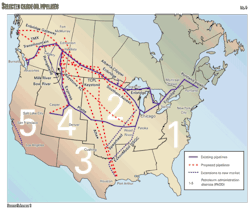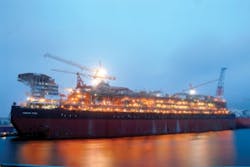Exploration field geoscientists have reported the existence of negative thermal anomalies over oil fields and have suggested that thermal profiling can be a useful, cost-effective tool for oil exploration.1 2
Though the idea appears to possess much commercial significance, it has still not been well investigated so far, owing to the fact that its field proving is laced with numerous difficulties. These include:
1. Logistical difficulties in collecting concurrent field temperature data over long profiles and extensive areas.
2. Moving field equipment for temperature measurements would involve elapsed time and hence natural diurnal temperature variation, and possible atmospheric-meteorological variations also need to be considered/normalized.
3. Topography, land use land cover, importantly vegetation and local surface moisture, may vary from place to place and also influence local surface temperature to a significant extent—and thus data reduction to a common base to allow lateral comparison becomes a difficult task.
In this context, satellite-borne remote sensing appears to be a powerful viable tool, as temperature data over millions of pixels are collected in a few minutes and solar illumination and atmospheric-meteorological conditions can be considered to be largely uniform for all practical purposes over the scene.
Further, multispectral optical data can be used to deal with the problems of vegetation and surface moisture to a practical reasonable extent.
Cambay basin example
We carried out this study in India's Cambay basin for possible detection of thermal anomalies from satellite sensor data.
Cambay is a marginal intracratonic basin situated in the western margin of the Indian peninsula and comprises a Tertiary sedimentary sand-shale sequence with more than 90 oil and gas fields, being covered by extensive monotonous alluvium.3 4
For this study we have used the ASTER satellite sensor data.5 Data processing includes data conversion, digitization, and computation of reflectance and temperature values using standard procedures6 7 from ASTER data. The temperature resolution of the space sensor is 0.2° K., and the methodology provides that the processed data output have a correspondence with field measured temperatures within ±1.5° K.
A systematic analysis of ASTER-derived temperature distribution at three known major producing oil fields reveals an interesting pattern.
The temperature estimates in four different spatial windows—the central pixel (each pixel represents a 90 m by 90 m area), and the mean values corresponding to matrices of 3 by 3, 7 by 7, and 11 by 11 pixels—indicate that the temperature at the central pixel is in the range of 299-300° K., and it gradually approaches the scene average of 306.3° K. as the matrix size is enlarged (Table 1).
Scene-based dedicated image processing has been carried out to mask and exclude pixels that carry possible effects of artifacts (urban areas, roads, etc.), water bodies (lakes, canals, and wet fields) and ground vegetation (forests, agricultural fields, parks, other vegetation, etc.) in the temperature distribution. This has enabled generation of images that show anomalous 'cooler' (temperature range 299-305° K.) pixels, which has been draped over the color infrared (CIR) composite image (Fig. 1).
A synoptic study of distribution of the anomalous pixels shows that many of them lie in clusters at selected locations that also lie within the boundaries of the known oil fields (Fig. 1).
Statistically, the distribution of the above 'cooler' pixels in the entire image is 0.9% (Table 2). However, over individual oil fields, the pixels of thermal anomaly appear in concentrations of 1.0%, 1.2%, 1.4%, and 1.9%. Further, there are regions of stronger aggregation of anomalous (cooler) pixels at certain locations within the areas of oil fields, such that some windows exhibit their clustering up to 1.5%, 2.3%, and 2.5% (Table 2).
It is interpreted that the observed thermal anomaly pixels are related to the thermophysical characteristics of oil at depth. Oil has characteristically lower thermal conductivity, higher specific heat, and lower thermal diffusivity than the reservoir rock. It is well known that there is a general geothermal energy flux from depth to the earth's surface. The presence of oil in a reservoir would change the effective thermal conductivity, thus causing spatial variations in heat transfer, resulting in relatively lower surface temperatures over oil fields.1
Thus, field data already exist on the presence of negative thermal anomalies over oil fields. It is shown here that processed satellite sensor data also exhibit preferential clustering of anomalous cooler pixels over known oil fields.
Based on the above empirical relationship, a possible prospect (e in Fig. 1) can be identified for further investigation. Finally, it may be mentioned that there lies a great potential in satellite sensor data which is yet to be fully investigated and exploited in exploration tasks.
References
1. Fons, Lloyd, "Temperature method can help locate oil, gas deposits," OGJ, Apr. 5, 1999, p. 58.
2. Fons, Lloyd, "Temperature anomaly mapping identifies subsurface hydrocarbons," World Oil, September 2000.
3. S.K. Biswas, "Regional tectonic framework, structure and evolution of the western marginal basins of India," Tectonophysics Vol. 135, 1987, pp. 307-327.
4. Nasipuri, P., Majumdar, T.J., and Mitra, D.S., "Study of high resolution thermal inertia over Western India oil fields using ASTER data," Acta Astronica, Vol. 58, 2006, pp. 270-278.
5. ASTER web site 2008 (http://www.asterweb.jpl.nasa.gov/).
6. ENVI User's Guide, Research System Inc., Boulder, Colo., 2005, p. 948.
7. Gillespie, A.R., Rokugawa, S., Matsunaga, T., Cothern, J.S., Hook, S., and Kahle, A.B., "A temperature emissivity separation algorithm for Advanced Spaceborne Thermal Emission and Reflection Radiometer (ASTER) images," IEEE Transactions on Geoscience and Remote Sensing, Vol. 36, 1998, pp. 1,113-26.
The authors
Rupam Chakraborty is keenly interested in petroleum geosciences and is working as a seismic engineer with Schlumberger in Mumbai. He graduated from Jadavpur University in 2005 and postgraduated from Indian Institute of Technology Roorkee with a master of technology in applied geology in 2008.
Chile
Apache Corp. plans to drill three wells on its onshore concessions in southern Chile's Magallanes basin by the end of 2009.
The company expects to spud Esmeralda A-1X on the 3,400-sq-km Rusfin concession within days. It is projected to 13,000 ft or Cretaceous Springhill. The concession surrounds depleted Lago Mercedes oil field (see map, OGJ, Dec. 24, 2007, p. 36).
The rig will then move north to the 1,640-sq-km Lenga concession to drill Carmen A-1X and Carmen B-1X, both to Springhill at 8,200 ft.
Russia
Lundin Petroleum AB, Stockholm, has spud the Petrovskaya-1 exploratory well on the Lagansky block in the northern Caspian Sea off Russia.
The well is on a fourway dip closure on trend, updip, adjacent to the northwest of the company's giant Morskaya oil discovery in less than 2 m of water. The area is just shoreward from Korchagin oil field, which OAO Lukoil is preparing to place on production in early 2010 (see map, OGJ, Aug. 11, 2008, p. 34).
Petrovskaya-1 is to go to 2,100 m and targets Lower Cretaceous sandstones. Gross unrisked prospective resource is estimated at 300 MMboe.
Morskaya field, which Lundin Petroleum discovered in 2008, was the Lagansky block's first significant identified structure with an estimated gross, recoverable resource of 230 MMboe in Aptian and Neocomian (Lower Cretaceous) sandstones.
Lundin Petroleum has a 70% interest in the 2,000-sq-km Lagansky block, the license to which has been extended until 2014.
Texas
West
Arena Resources Inc., Tulsa, finalized a contract with an undisclosed pipeline operator to transport about 95% of oil production from Fuhrman-Mascho field in Andrews County, Tex.
Construction began Oct. 16 on a gathering system that will connect most of the field's existing and new tank batteries, taking an estimated 70% of production by the end of 2009 and 95% ultimately.
The arrangement is expected to save $1/bbl and widen marketing options. Some 5% of output will continue to be trucked. The company's total production averaged 6,000 boe/d in the quarter ended June 30.
More Oil & Gas Journal Current Issue Articles
More Oil & Gas Journal Archives Issue Articles





